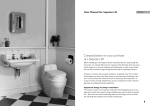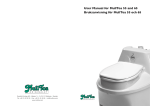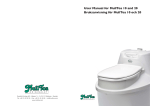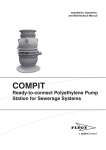Download User Manual for MullToa 10 and 25
Transcript
User Manual for MullToa 10 and 25 User Manual for MullToa 10 and 25 Congratulations on your purchase of MullToa toilet Your bio-toilet is patented and manufactured in Sweden and the brand is MullToa. MullToa means that it produces natural humus in the actual unit, without the use of water or chemicals. Our largest model has been awarded the Nordic Ecolabel (the Swan mark). 1 INTRODUCTION Please read all these instructions before beginning to install your MullToa toilet. Experience has shown that problems that usually occur are almost always related to installation and maintenance. To ensure hassle-free use, please take a moment to read through the manual. Three important things to always remember: – When the toilet is in use the room temperature must be at least 18°C. – If you are away for more than two days, you should always switch the power off, otherwise the compost will become dry. Switch the power off and place the cover over the seat opening. The moisture content is an important component of the biological process, so it is important to retain the moisture as long as possible, even when the toilet is switched off. – Apart from the natural needs being taken care of during a visit to the toilet, the only thing that should go into the toilet is toilet paper. Your new MullToa experience starts here! We hope you will be completely satisfied. CONTENTS How MullToa works Contacting Environmental Health Your MullToa package Installation package Optional accessories MullToa cross-section – all parts Installation What you need Pipe installation Temperature Air supply Assembly Starting the empty toilet Maintenance Extra humus starter Mixing 2 3 3 3 3 3 3 4 4 4 4 4 5 5 6 6 6 Setting the thermostat 6 About the liquid in the level tube 6 Keeping the compost at right temperature 6 Emptying frequency 7 Emptying in spring 7 Emptying the tray 7 Prepare for a couple of days or more 7 At the end of the season 7 At the start of the season 7 FAQ 8-9 Bad odour 8 Compost too dry 8 Compost too wet 8 Replacing the break-pin 9 Spare parts and service 9 How the MullToa works The MullToa is a biological toilet that composts waste and evaporates liquid, in the toilet itself. The composting process takes place using nature's own microorganisms, without the need of any chemicals. The toilet should be used as any other. Controlled air supply and heat, as well as regular mixing of the compost, accelerates the composting process and converts the waste into eco-friendly humus. This makes a nutrientrich supplement for your garden. Contacting Environmental Health Contact Environmental Health office regarding local health regulations. This always applies when installing any type of toilet. Your MullToa package The MullToa box contains: A toilet, a 50 cm humus rake and a bag of humus. The installation package (accessories) The installation package contains: ventilation pipes, (4x1.1 m ventilation pipe with 55 mm outer diameter), exterior pipes (2 x 0,5 or 1,0 m, 110 mm outer diameter), insulation (2 x 1 m), reducing coupling, roof flashing and insect netting. Optional accessories Optional accessories: pipe bends (30° and 45°), additional insulation, straight pipes, humus starter, an extra tray and a kit for installation through the outer wall. MullToa in cross section 1. 2. 3. 4. 5. 6. 7. 8. 9. 10. 11. a. b. c. 12. 13. 14. 15. 16. a. b. 17. 18. 19. 20. 21. 22. Rubber coupling Adjustable thermostat Fan motor Terminal block with flat pin connection Heating element Airflow External cord Composting chamber Tray Handle Switch for mixer motor Nut for switch Nut for compost cover Mixer motor (MullToa 25) Cover Compost cover Shear-pin Shaft with mixer arms upper mixer arm lower mixer arm Airflow Grating Front cover Liquid tube, overflow (at the left hand side, seen from the front) Liquid tube, tray (at the right hand side, seen from the front) Lower heating element (MullToa 25) 3 INSTALLATION What you need For installation you need to have the following tools available: – Drill – Hole saw (55 mm) or Compass saw – Saw – Metre rule/measuring tool – Asphalt sealant/adhesive Also check that the floor area where the toilet is to be positioned is large enough. The floor area required is: Width 55 cm x Length 110 cm (for the toilet and removal of the humus tray). Pipe installation All pipes going through the ceiling into cold spaces (e.g. the attic) must be insulated. This is to prevent draughts and condensation in the ventilation pipe. Insulation is essential, regardless of how much or how little the toilet is used. Do not use pipe bends over 45°. Do not use a rain cap on top of the ventilation pipe - the air must be allowed to flow out freely. Only the insect netting should be on top of the pipe. Temperature The room in which the toilet is installed must be insulated. When the toilet is in use the room temperature must be at least 18°C to ensure it functions properly. The easiest thing to do is to fit a thermostaticallycontrolled radiator. If the toilet is not in use then the temperature need not be controlled, low temperatures will not damage the unit itself. Air supply In order to ensure adequate air supply, a vent should be installed in the exterior wall. The exhaust air is evacuated through the toilet. Avoid having a bathroom fan in the toilet room as it creates a back draught, which can lead to odours in the room. 4 Assembly 1. Set the toilet in position against the wall. The floor must be even and insulated. Insect netting Reducing coupling 25 mm Insulation 2. Measure and make a hole for the ventilation pipe in the ceiling, with 55 mm diameter. Install the ventilation pipe with the non-sleeved end down inside the rubber coupling on the toilet. Roof flashing MAX 45° 3. Measure and make a hole in the roof, with 55 mm diameter. 25 mm Insulation VENT alternative 4. Push the pipe up through the hole. Seal it well using asphalt sealant between the pipe and the roof to prevent any leaks. 5. Insulate the pipe from the ceiling up to the top. All pipework in cold spaces must be insulated. Eng Pipe 110 mm MIN. 0,5 m 18° C Ventilation pipe 55mm Radiator VENT alternative 6. Cut the exterior pipe to fit the angle of the roof. 7. Place the roof flashing onto the exterior pipe. (Use soapy water to make it easier). If you have a tin roof, the best thing to do is to get a lead worker to create a junction between the roof and the exterior pipe. 8. Pass the exterior pipe over the ventilation pipe's insulation. Put on the reduction coupling. 9. Adjust the roof flashing and seal firmly with asphalt sealant between the roof flasing and the roof. Roof flashing Nonsleeved end Sleeved end seal of asphalt Roof (brick, paper or plate/plastic) 10.Fit the insect netting against the stop on the reducing coupling. Starting the empty toilet 1. Pour 2/3 of the humus starter into the toilet. About half of the humus starter will fall down through the grating into the tray. 2. Plug into an earthed socket. Open the lid and the motor will start automatically and run for a short while. Close the lid and the motor will make one turn. Repeat this a couple of times. On model 10 you need to turn the handle clockwise at least a couple of times to distribute the humus starter. The tray fills up immediately and should stay this way until the compost level reaches the upper mixing arm. 3. Setting the thermostat. This depends on how many people are going to use the toilet. See recommended use in the separate sketch under maintenance instructions, page 6. 5 MAINTENANCE A properly installed and maintained MullToa is odour-free. We emphasise this to highlight the importance of reading the maintenance instructions carefully. If it is not working as it should it has usually something to do with installation or maintenance. Of course we want your MullToa to work, hassle-free, and we therefore ask that you please take the time to read through this information in its entirety. Thank you in advance and enjoy your new MullToa toilet! Extra humus starter For the best composting, the compost must be of a porous and moderately moist consistency. At low load, or 1-2 people, calculate around 1/2 litre per person per week. At higher loads, or 3-4 people, halve the amount. If four people a day use the toilet, two litres of humus should be added into the compost every week. Use the humus rake to mix the humus in. If hard lumps form in the compost, make sure you break them up. Hard lumps can be a sign that the heat is too high. If this is the case, turn the thermostat down. Mixing When the seat cover is opened, the motor will start automatically and run for a short time. Close the lid after the toilet has been used. The motor will start again and complete a full turn. On model 10, the handle should be turned clockwise at least a couple of times to distribute the humus starter. This is so that waste and paper will be mixed into the compost and to make it more porous. This is essential for efficient composting. Setting the thermostat Before the first use the thermostat should initially be set according to how many people will be using the toilet. Number of people 1–2 3–4 Emptying Recommended setting at start 1-5 8 10 For higher or lower loads, you can easily change the setting, as recommended below. HOW TO SET THE THERMOSTAT Adjust the thermostat according to load. Check the liquid tube ( 21) on the right hand side. On the Model 25 the thermostat works in two steps depending on settings. • At level 1-7 the main heating element (5) is working • At level 8-10 the main heating element (5) and the lower heating element (22) are both working. LIQUID IN THE LEVEL TUBE The level tube (on the right side, viewed from the front) shows how much liquid is in the tray. There will always be some liquid in the tray, but the whole tube should definitely not be full; this would mean the whole tray is full of liquid. One centimetre of liquid in the tube is OK. If your compost is too moist, or if you have an extra load over a longer period of time, turn up the thermostat. RIGHT TEMPERATURE At the right temperature, the compost has a porous and moderately moist consistency. If liquid stays on top of the compost and seeps down into the tray slowly, then the compost is too wet and can no longer absorb the liquid as intended. Increase the thermostat setting slowly and add a few litres of humus starter. On the other hand, if hard lumps form or toilet paper remains on top, so that it doesn't get soaked and mixed in properly during mixing, the compost is too dry. If so, turn the thermostat down. 6 EMPTYING FREQUENCY In vacation homes, with a four to six weeks stay per year, it is usually enough to empty the tray once. But, at more frequent use, you have to adapt the emptying frequency. The general rule is to empty the tray when the compost level reaches the upper mixing arm.You soon learn to adapt the emptying frequency according to use. The tray will be filled up again after a couple of days in use. EMPTYING IN SPRING Where you can get by with one emptying a year, leave the compost in the toilet over the winter. The tray is then emptied in the spring before the toilet starts to be used. EMPTYING THE TRAY A few days before emptying, increase the thermostat to 10 to dry up the liquid in the tray. Once it has disappeared from the level tube, do as follows: 1. Switch the power off! 2. Make sure that there is no liquid in the level tubes on the right or left. 3. If there is liquid, increase the thermostat setting and wait a few days before emptying. 4. Emptying: Remove the front cover. Remove the hose to the tray. If the tray is stuck in place, due to compost between the tray and the grating having dried out, release the tray by pulling the humus rake back and forth between the tray and the grating. 5. Empty the tray in a suitable place for post-composting, such as in the garden compost. 6 Clean the tray. Before you slide it into place, check that the area where the tray goes is clean. 7. Replace the level tube. Replace the front cover. For more frequent use, the more often the tray has to be emptied. If the toilet has not been used for the last 2 months, the contents in the tray can be used as fertilizer immediately. But, when emptying the tray in the middle of the season, the contents needs to compost further for about 2 months. Remove the full tray and replace it with an additional tray (which can be bought from us). Put the full tray in a plastic bag. Prepare for brief absences If you are away for more than two days, turn the power off and put the cover into the seat opening, otherwise the compost will quickly become hard and dry. If there is a lot of liquid, for example, after heavy use, you can leave the toilet running for a limited period (approximately one week). Leave the toilet running with the thermostat in position 1. Then only the fan will run, and the contents of the tray will dry out slowly. At the end of the season When the season is over and it is time to leave your holiday cottage, unplug the toilet and put the cover in the seat opening.You can also turn off the heat in the toilet room, as the MullToa cannot freeze and break. New season approaching When the season is approaching, and it is time to open up your cottage, it is also time for the MullToa to be used again after a long break. Check if the compost has become hard. This is especially important on MT25, otherwise the shear pin might break.If so, break it up with the rake. Then emplty the tray. If there is less than 5 cm of compost on the grate, add som more humus starter. 7 FAQ – How do I know if the compost is too dry? Answer:The forming of hard lumps indicates that it is too dry. Another indication is that toilet paper remains on top instead of becoming wet and getting mixed in properly during mixing. – What do I do if the compost becomes too dry? Answer: Use the thermostat to reduce the heat to a lower level and spray some water on the compost, at the same time it may be useful to break up the compost through the seat using the humus rake supplied.You should also use toilet paper sparingly, as this is broken down more slowly when the compost is too dry. If the compost is consistently too dry, despite the thermostat being at position 1-2, then you can install a timer that turns the toilet power off at night. – How do I know if the compost is too wet? Answer:When the compost is no longer able to absorb liquid, and it sits on top of the compost. – What do I do if the compost becomes too wet? Answer: First check that power is reaching the toilet, so that the fan and heat work. If the fan and heating element are working correctly then you should be able to hear it and also feel the heat from the back of the toilet with your hand.Then check: – That the ventilation pipe has been installed according to the instructions and that it is well insulated. – That the temperature inside the room is at least 18°C. – If the toilet has been overloaded (if so, the thermostat setting needs to be adjusted). – That there is plenty of air being supplied through the wall vent. Drying up the compost, do the following: 1. Mix a few litres of MullToa Special Humus into the moist compost. 2. If there is also liquid in the level tube, turn the thermostat up to a higher setting. Do not turn it down to a lower setting until the liquid regains its normal level. 3. If there is liquid in the level tube on the left side as viewed from the front, the tray has overflowed. Raise the thermostat and wait a couple of days before emptying. 4. If the compost does not become drier, the excess liquid will need to be emptied out. Loosen the level tube at the top and connect a garden hose. Note: Do not open the front cover. – What can be put in the toilet? The toilet can be used like any other, including for the disposal of toilet paper. However, the disposal of items such as sanitary towels or tampons, cigarette butts, or burning or glowing objects is not allowed. – What do I do if there is a bad odour in the toilet room? Answer: A properly installed and maintained MullToa is completely odour-free. If you do experience a bad smell in the toilet room, it is an indication that something is wrong. Make sure you have carefully followed the installation and maintenance instructions (using the quick-guide below) and you will probably be able to determine the cause of the malfunction. 1. 2. 3. 4. 5. 6. 8 Check that the Biolet is getting enough air through a vent in the outer wall. Make sure the front cover is closed properly. Avoid draughts by not having both windows and vents open at once. Check that the pipes fit the toilet properly. Check that the pipe joints are sealed completely tight. Check that any pipe bends you have are not over 45°, and that you do not have more than two bends. – What do I do if the mixer motor does not work (MullToa 25)? The mixer motor is protected in two different ways in order to prevent damange on mechanical parts. – The motor runs normally, but the mixing arms do not move! There is a shear pin mounted in the motor shaft. When the resistance is too tough, the shear pin breaks and must be replaced. – The motor starts and stops and after a while it starts again by itself, but the mixing arms are still not moving! The electrical motor has an overheating protection, which activates if the resistance is too high. It will turn itself off. But it will try again after a while and it will repeat this until the high resistance in the compost has been resolved. It usually is enough by mixing the compost using the manual rake and adding a few litres of humus starter. See “What do I do if the compost becomes too dry” page 8 – What do I do if the shear-pin breaks (MullToa 25)? 1) Unplug the toilet. 2) Lift the toilet at the front, pull it forward and loosen the ventilation pipe. 3) Unscrew the round nut holding the switch (11b) for the mixer and press the button inside the plastic. 4) Loosen the nut for the compost cover (11c). Lift the upper section. 5) Disconnect the wires that connect the mixer motor (12) to the terminal block on the electrical panel. Memorise their positions before disconnecting them. 6) Remove the four Phillips screws holding the mixer motor in place in the lower section. 7) Lift the mixer motor straight up. (If the mixer motor is wedged in the shaft, then try lifting the motor up while you rotate the shaft with an adjustable spanner.) 8) Working on a rigid surface or by fastening the motor shaft in a vice, tap out the remains of the broken shear-pin (15) using a mandrel or the new shear-pin. 9) Tap in the new shear-pin and put the mixer motor back. 10) Reattach the wires to the terminal block. 11) Perform a test run. 12) Replace the top section, the round nut holding the switch for the mixer in place and the nut for the compost cover. 13) Put the toilet in place. 14) Switch the power back on. – When do I need to call a qualified electrician? MullToa is approved for installation in bathrooms. If the main cord is damaged it must be replaced by the manufacturer or its repair business, or another qualified person, to prevent injury. This warning is placed near the toilet. – Where do I get parts and service? Contact you national dealer. Always have the serial number and model at hand.This information can be found on a sticker at the upper back of the toilet. 9 Swedish Ecology AB Klippan 1J S-414 51 Göteborg Sweden Tel: +46 31 42 29 30 Fax: +46 31 42 49 08 [email protected] www.mulltoa.com




















